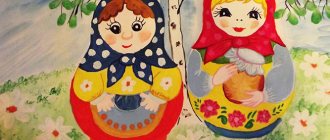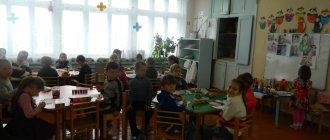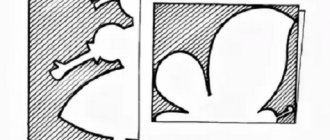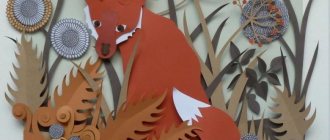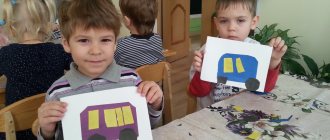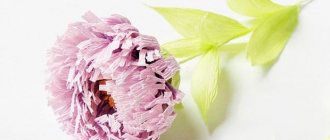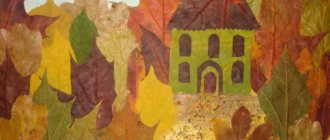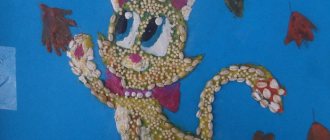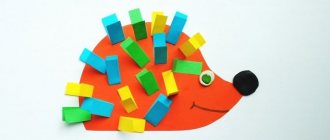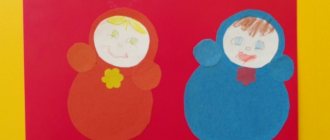Goals: -
learn how to perform laconic, expressive decor (i.e., design a product in accordance with its purpose);
- introduce the history of the matryoshka doll;
- promote the development of graphic skills, artistic taste, creative imagination, stylistic harmony, understanding of the expediency of things;
- cultivate respect for folk traditions and a sense of mutual understanding.
Equipment:
– colored cardboard (1 sheet), colored paper, glue (PVA), wooden matryoshka – toys; – flowers made of fabric, postcards, reproduction of Kustodiev’s painting “Maslenitsa”, templates, flannelgraph, signal cards.
Note:
seating children in groups.
During the classes.
- Introduction to the topic.
1. Goal setting.
- I invite you to the “Wonderful Workshop”. Each of you today will create miracles with the help of a variety of objects.
- And what miracles these will be, you can guess for yourself.
- Try to determine from these signs what we have to do in the workshop. "Fig.1"
- Safety precautions.
- What do you think we need to keep in mind to ensure we enjoy working in the workshop? (Reliance on objects drawn on signs.)
- Positive attitude.
- Remember that the signs, with the help of color, also told us what the mood should be during work; help each other, then our products will radiate warmth and kindness.
- A conversation about the birth of the Russian nesting doll.
- Check out what's on the tray in our workshop. (Show objects, students name them.)
- Demonstration of a matryoshka doll.
- You named this toy correctly. (The teacher takes out one nesting doll from another.)
Guys! I have been ordered to bring the decree to you at this hour. Prepared by Our Mother herself - in winter, everyone! Everyone! Everyone! Only with us, only for you, a ringing, cheerful fair opens. (Show words)
Usually the fair opened on Maslenitsa.
This is an old, cheerful holiday of farewell to winter.
Russian artists depicted this event on their canvases. Here is a reproduction of Kustodiev’s painting “Maslenitsa”. (Show the picture)
In the foreground is a picture of three horses harnessed to a sleigh. In the old days, people went to the fair on a sleigh. (Video recording: an episode from N. Mikhalkov’s film “The Barber of Siberia” is shown. Commentary.) And what happened at the fair during Shrovetide.
The nesting dolls were walking along the path. There were a few of them. Two Matryoshkas, three matryoshkas and one Matryoshka. (Take out the Matryoshka dolls.)
- How many of you know poems about matryoshka dolls?
1st group:
Eight wooden dolls, round-faced and ruddy, in multi-colored sundresses. They live on our table; everyone is called matryoshka dolls.
Group 2:
Like a turnip, she is steep-sided And under a scarlet scarf Looks at us cheerfully, smartly, widely With a pair of black currant eyes.
Group 3:
Dapper matryoshka doll – Sundress with fastening – Twisted eyelets Cast buttons.
- The history of the matryoshka doll.
More than a hundred years ago, a wooden toy was brought from Japan: an Old Man with an elongated head. His name was Fuguruma. The sage's head stretched out in thought. I liked the toy, and the artist S. Malyutin came up with our Russian nesting doll, and it was turned by turner V. Zvezdochkin.
The toy got its name from the Russian name Matryona
.
The first nesting doll depicted a girl in a sundress with a rooster in her hands. (Show illustration.)
Then they appeared:
- Zagorskaya;
- Semyonovskaya;
- Polkhov - Maidan.
The artists chose their design - decor. (Refer to the dictionary.)
There is a sense of harmony in every toy, i.e. size and colors are combined. I found an explanation of these words in the schoolchild’s encyclopedic dictionary “Art”. (The teacher shows the book to the children.)
Result:
We looked at a lot of interesting things in our workshop. And we will demand to create our own product - a matryoshka doll (in unison). (“Fig.1” sign “Eye”)
- Modeling a matryoshka doll on flannelgraph.
- Our task is to model a matryoshka doll. (Show the “?” sign “Fig. 1”.)
- What do you think will help us? (Templates)
- Select the templates you need and try to assemble a matryoshka doll from them.
- How many parts did you find? (Three)
(1 student models on a flannelgraph, the rest on tables.)
Result:
We modeled a matryoshka doll and dealt with this problem. (Remove the flannelgraph.)
Y. Manufacturing of parts using templates.
- Choice of color, technology of making parts.
- Independent work.
– Let’s use the templates you chose to make the parts of the nesting doll.
– Choose a sheet of colored cardboard for the base and colored paper for the details so that they match the character of your future nesting doll. Think about what kind of her you will have: cheerful, kind, caring, a craftswoman.
– How to use the template correctly? (Show by student at the blackboard)
a) tracing the templates; (Checking readiness. Show the “Pencil” sign “Fig. 1”.)
Result:
Circled! (Remove the “Pencil” sign “Fig. 1”.)
b) cutting out parts. (Safety precautions, sign “Scissors” “Fig. 1”.)
Result:
Cut out the details. We prepared everything for assembling the nesting dolls.
– Put away the scissors, we don’t need them anymore. Clean up your workspace.
PHYSICAL MINUTE.
(I play the violin.)
The fun is over. Get down to business.
Turn over the sign: “Cheerful face” “Fig. 1”.
VI. Assembling a matryoshka doll. Gluing parts.
- We will dress up the matryoshka doll.
- What to stick first? (Handkerchief).
- Face oval.
Result:
We put on a matryoshka doll. (Glue sign “Fig. 1”.)
VII. Face painting.
- What is missing? Try to bring the matryoshka doll to life.
- And how to do it? (Draw a face) Convey the character of the matryoshka doll in your facial expression, just as we tried to do when choosing a costume.
VIII. Creative work. Decorative painting of a matryoshka doll.
- Is it possible for our nesting dolls to go to the fair? (Forgot your holiday outfit.)
All nesting dolls love colorful clothes.
- What can you use for decoration?
Work in groups.
(Remember harmony.)
1 group
: Decorate with flowers cut from fabric.
2nd group
: Decorate with flowers cut from cards.
3 group
: Let's try to entrust you to develop and create your own decor from various colored geometric figures.
(Refer to the signs that the teacher turns over after each stage.)
- Maslenitsa
- one of the ancient holidays in Rus'. All week old and young have fun, saying goodbye to winter and hastening the arrival of spring.
Each of the seven days of Maslenitsa week has its own name and its own custom. Today is Thursday – “Run out”. And it’s no coincidence that after we completed everything, the word “Round Dance” came out (the children read in chorus.)
All the people are looking out the windows: The nesting dolls have started dancing. Eight are dancing in a circle, And the ninth is singing.
Children with finished products stand in a round dance, showing them to each other.
- Let's call spring! Remember the chants that were taught in extracurricular reading lessons:
Nicknames:
1.
Spring, red spring! Come, spring, with joy. With joy, with great mercy.
2.
Oh, you larks, larks. Fly into the field. Bring health, The first is cow, The second is sheep, The third is human.
3.
A sandpiper flew from across the sea, The sandpiper brought nine castles. Sandpiper, sandpiper! Close winter, open spring. Warm summer.
So the sun has set
Our fair has closed.
Summary of direct educational activities in the senior group “Matryoshka”
Lesson notes on the application “Matryoshka”
MBDOU No. 62 “Rodnichok”
Authors: Kazachkova Elizaveta Sergeevna - teacher,
Dvoretskaya Elena Arkadyevna - teacher
Age:
senior group
Subject:
"Matryoshka"
Purpose of the lesson:
To promote the ability to create an image of a folk toy (matryoshka) using the appliqué technique.
Tasks:
1. Teach children to analyze a sample to identify characteristic features
(Components: face, hands, sundress, scarf)
2. Teach children to consciously select matryoshka parts in the chosen color scheme.
3. Continue training in work planning.
4. Teach how to capture an idea in an original artistic image.
5. Continue teaching how to cut out an object using a stencil and carefully stick on the applique elements
Equipment:
paper, fabric, glitter, scissors, glue, brush, pencil.
Bibliography:
Arapova S.V. Fine arts training. Integration of artistic and logical. - St. Petersburg: KARO, 2004. - (Modernization of general education).
Gusakova M. A. Application. - M.: Education, 1982.
Dubrovskaya N.V. Invitation to creativity: teaching preschoolers the technique of appliqué and collage. - St. Petersburg: “CHILDHOOD-PRESS”, 2004. - 128 p.
Progress of the lesson:
Organizing time.
Hello guys.
What could such a box be filled with?
Of course, with old Russian things. I'll tell you a secret. The box is filled with toys.
So, let's open the box? I'm looking for a wonderful toy. Guess which one?
We're at the fair
They brought you a chest - a gilded barrel. That chest is not simple, and the goods in it are painted. We take it out for display - And we tell a story about it.
A scarlet silk scarf, a bright sundress in a flower, resting the hand on the wooden sides. And inside there are secrets: Maybe 3, or maybe 6. She didn’t blush a little (children’s answers...? Matryoshka)
Presentation and conversation.
Now I’ll tell you guys about this wonderful toy – a matryoshka. After all, you probably have such a house and a toy?
Who has?
The first Russian matryoshka was an eight-seater: a girl with a black rooster was followed by a boy, then a girl, and so on. All the figures were different from each other. The last one, the eighth, depicted a baby.
Initially, this doll didn’t even have a name. But when the turner made it out of wood, the artist painted it with bright colors, then the name appeared - M?atryona. Perhaps this is due to the fact that at various evenings tea was served by a servant with that name. Why was everyone’s favorite Russian doll-toy called “matryoshka”? Many believe that this name comes from the female name Matryona, very popular at that time in Russia. The name Matryona, translated from Latin, means “noble woman.” Looking at the matting doll, the image of a portly, noble and toy really appears.
Step-by-step instruction
The “matryoshka” applique in the preparatory group is an excellent activity that will help preschool children learn how to work with templates and acquire skills in handling fabric and other materials.
Making an applique from fabric is not a difficult job. First of all, children should prepare their workspaces by removing everything unnecessary and leaving only the necessary materials and tools on the tables. Using a template, you need to cut out a matryoshka figure from cardboard.
Next you will need fabric. Using a template, a matryoshka costume is cut out of it and glued to the base. After this, you need to cut out the head and also glue it to the base. Separately, cut out a round face from light fabric. Using felt-tip pens, draw eyes, a nose, a mouth, rosy cheeks on it and glue it to the base. Additionally, the craft can be decorated with braid, sparkles, sequins, etc.
Matryoshka dolls using the Kinusaiga technique
Japan has presented many interesting techniques to handicraft masters, and kinusaiga is one of them. Its essence is to cut grooves in the foam and thread pieces of fabric into them. This technique is more complex than the previous ones, so it can be offered to children of high school age.
For stronger fixation, the center of the flaps is glued to the foam with glue. This technique is a great way to decorate a box. Polystyrene foam with ready-made grooves along the contour of the pattern is glued to a cardboard base or directly to the lid of the box. Then pieces of fabric are inserted according to the design and the product is decorated with ribbons, braid or beads.
Advantages of making matryoshka appliqués for children
Classes on making nesting dolls from paper and fabric pose some tasks that accompany the child’s development:
- Educational. Children get acquainted with folk toys, learn to distinguish colors, patterns and highlight individual elements of Russian folk clothing. In addition, kids try to carefully cut out and paste individual elements, and they develop aesthetic taste.
- Educational. Children become familiar with traditions and get acquainted with a toy, which is a symbol of Russian folk art.
- Developmental. The application “matryoshka” in the younger group and working on it helps develop children’s attention, speech, memory, observation, and fine motor skills. Children develop an interest in applications and in creating all kinds of compositions.
